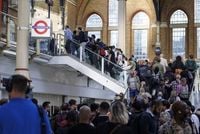Londoners awoke on Monday, September 8, 2025, to a city once again grappling with the ripple effects of widespread Tube strikes. The familiar hum of the Underground was replaced by the whirr of e-bike motors, the shuffle of hurried footsteps, and the grumble of crowded buses as commuters navigated a capital transformed by industrial action. For some, it was a day of frustration and fatigue; for others, it was an opportunity to embrace new ways of getting around—highlighting just how much London’s transport landscape has changed in recent years.
The strikes, organized by the RMT union, began on Sunday, September 7, and are set to disrupt the Underground network until Friday, September 12. Every Underground line has been affected, with the Docklands Light Railway (DLR) also shuttered on September 9 and 11. According to The Independent, talks between the union and Transport for London (TfL) broke down on September 3, with neither side showing signs of budging. No further meetings are planned, and the RMT has warned that more strikes could follow if their demands are not met.
At the heart of the dispute are calls for better pay, improved working conditions, and a reduction in working hours. The RMT is pushing for a four-day, 32-hour working week to address what it describes as “exhaustion” among staff. “Fatigue and extreme shift rotations are serious issues impacting on our members’ health and wellbeing – all of which have not been adequately addressed for years by LU management,” said Eddie Dempsey, the RMT’s general secretary, in comments reported by The Independent. The union’s members, including not just Tube drivers but thousands of station and depot staff, voted overwhelmingly—96% in favor on a 57% turnout—to take strike action.
Jared Wood, the RMT’s London Transport Region organiser, offered a glimpse into the daily grind faced by London Underground workers. “People on London Underground will typically work a roster where they may do seven shifts starting at 4:30am. Then they move to middle shifts, then to late shifts finishing at 1 or 2am, and many work overnight as well. We do that on a constant cycle where bank holidays and weekends are considered normal working days. And it is exhausting,” he told London Centric. Wood stressed that the union is not demanding an immediate switch to a 32-hour week but wants an incremental move toward it. “The only way you can recover is with more quality time away from the workplace. And that’s what we’re asking for.”
TfL, however, insists that the RMT’s demands are neither practical nor affordable. Claire Mann, TfL’s chief operating officer, stated, “A reduction in the contractual 35-hour working week would be neither practical nor affordable. Our pay deal is in line with other offers accepted by the RMT across the rail industry, so it is disappointing the RMT is planning to disrupt Londoners without giving their members a say on the offer.” TfL has offered a 3.4% pay rise and maintains that it is open to further discussions on managing fatigue, but only within the bounds of financial sustainability.
For commuters, the impact has been immediate and, in many cases, severe. On September 8, the vast majority of Underground lines had no service, with only limited trains running in the suburbs. According to The Independent, alternative routes such as the Elizabeth line, London Overground, and buses have stayed operational, but these services are far busier than usual. The London Overground linking Stratford with Clapham Junction and Richmond experienced delays of up to 20 minutes due to overcrowding. Chiltern Railways from Wembley to Marylebone was also disrupted during the Monday morning rush hour.
The economic fallout is significant. Kate Nicholls, chief executive of UKHospitality, told The Independent, “This is having a devastating impact on the busy first week back to work and school. We estimate cost to our members is £110m. The overall economic hit to London is estimated to be twice that.” Even the entertainment sector has not been spared: Coldplay rescheduled the final two dates of their Wembley Stadium gigs, citing the Tube strikes as the reason.
Yet, in a sign of the times, the impact of the strikes appears to be blunted by Londoners’ growing reliance on alternative modes of transport. Rental e-bikes, particularly those operated by Lime and Forest, have seen a surge in demand. According to BBC London, Lime reported a 58% increase in trips between 7:00 and 11:00am on September 8 compared to the previous Monday. Forest bikes saw a staggering 122% increase in riders during the 7:00 to 8:00am window, while Santander bike usage jumped by 61%. “Standing at Ludgate Circus near St Paul’s Cathedral with a clicker at 9am, we counted 81 Lime e-bikes pass us during a single change of the lights,” London Centric reported, highlighting just how many commuters have turned to two wheels.
For some, the switch to cycling or walking was a necessity rather than a choice. “Was a two hour journey, should have ridden a bike for the first time in 11 years,” said Rebecca, a commuter waiting for a bus outside Oxford Circus station, to London Centric. Others, like Abbie, a young office worker, expressed surprise that the strikes went ahead: “I thought they’d be cancelled because of the impact, but I suppose people have to have their say. Super inconvenient. It normally takes me 25 minutes to commute but I left at 8am and arrived at 9:40am. It was a horrible journey.”
The shift in commuting habits is also being driven by technological change and the legacy of the pandemic. Remote working has become a viable option for many office employees, reducing the number of people who absolutely must travel into central London. The Elizabeth line, a high-capacity rail route that did not exist during previous decades of strikes, has absorbed much of the displaced Tube traffic. According to London Centric, about half the commuters on the Elizabeth line said it was their normal route, while the other half were using it to avoid strike-affected lines.
Despite the disruption, some Tube staff on picket lines emphasized that their strike is about more than just pay. Eve, a station supervisor, told London Centric, “The whole idea for 32 hours a week is not because we’re lazy. If you’ve done shift work, you know how tiring it can be, especially on night shifts.” She described the toll of rapid shift changes and the exhaustion that comes with them: “That creates a complete and utter discombobulation with your body clock.” For many, the quest for a better work-life balance is as important as financial compensation.
Politically, the dispute has become a test of wills. While Mayor Sadiq Khan intervened to avert strikes in early 2024, this time he is staying out of the fray. A spokesperson for the mayor said, “Nobody wants to see strike action or disruption for Londoners. Strikes have a serious impact on London’s businesses and commuters. The mayor continues to urge the RMT and TfL to get around the table to resolve this matter and get the network re-open.”
With no resolution in sight and the RMT holding a six-month mandate for further strikes, Londoners may need to brace for more days of disrupted commutes, crowded buses, and a city that, while inconvenienced, is proving surprisingly adaptable to life without the Tube.




